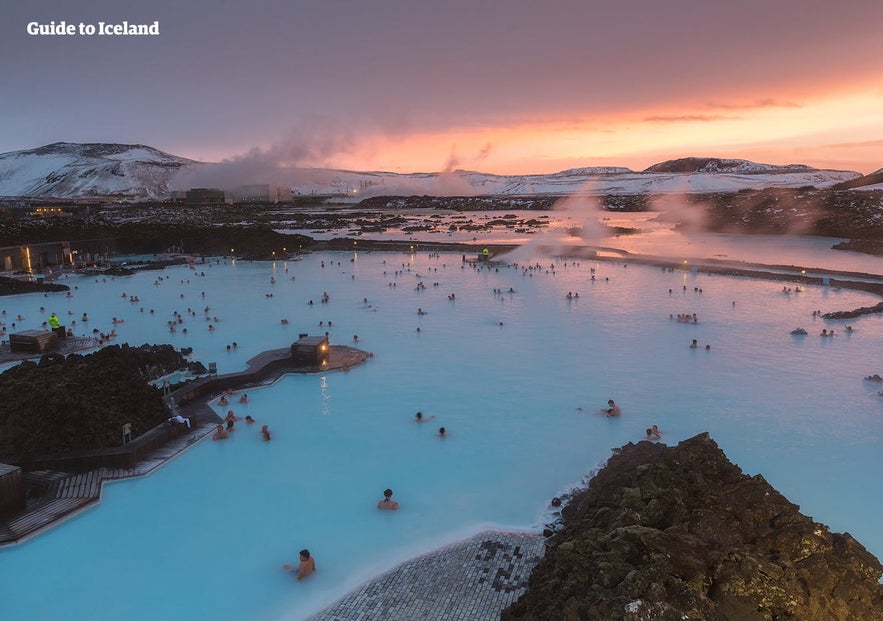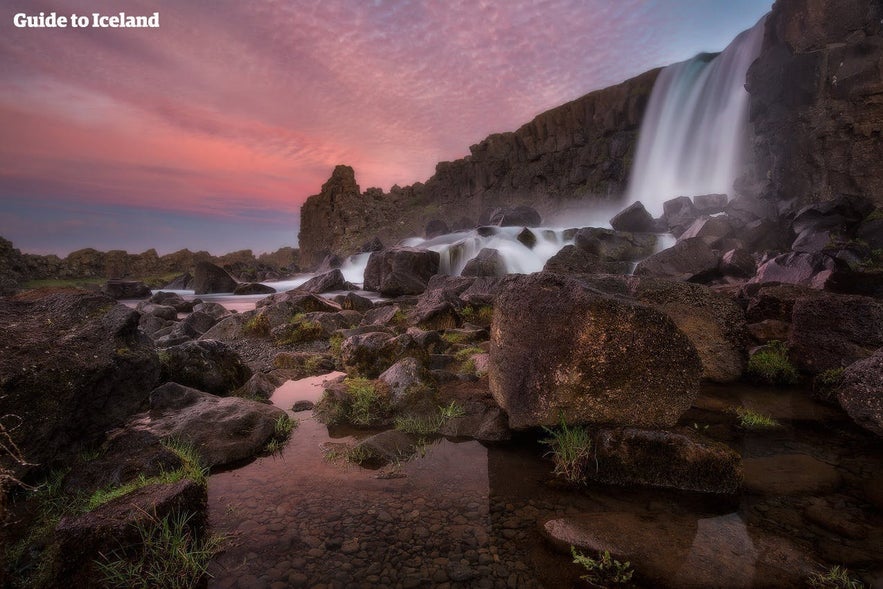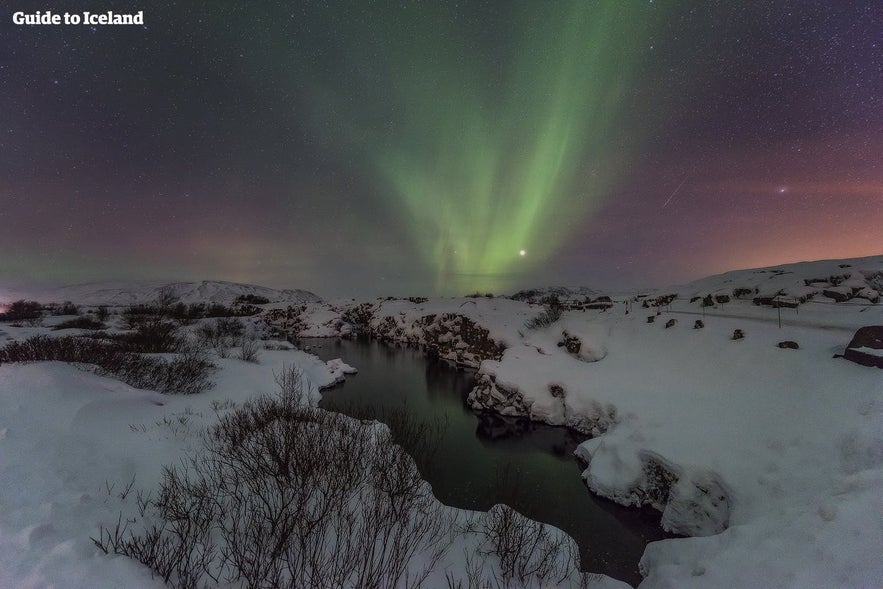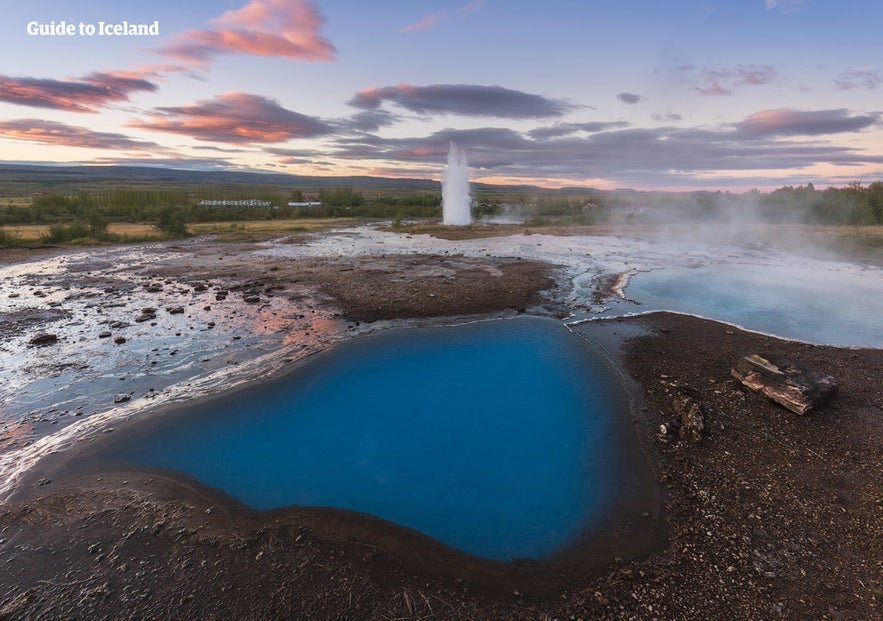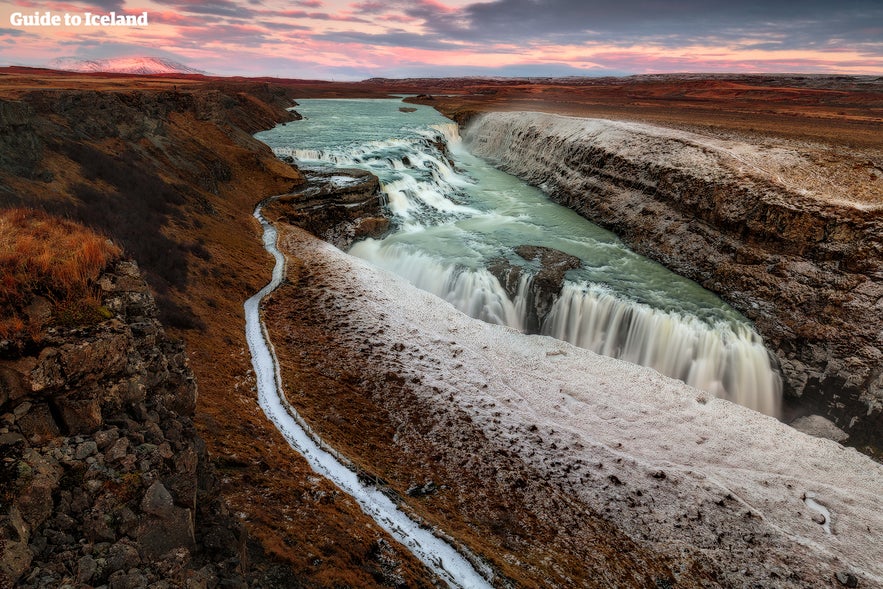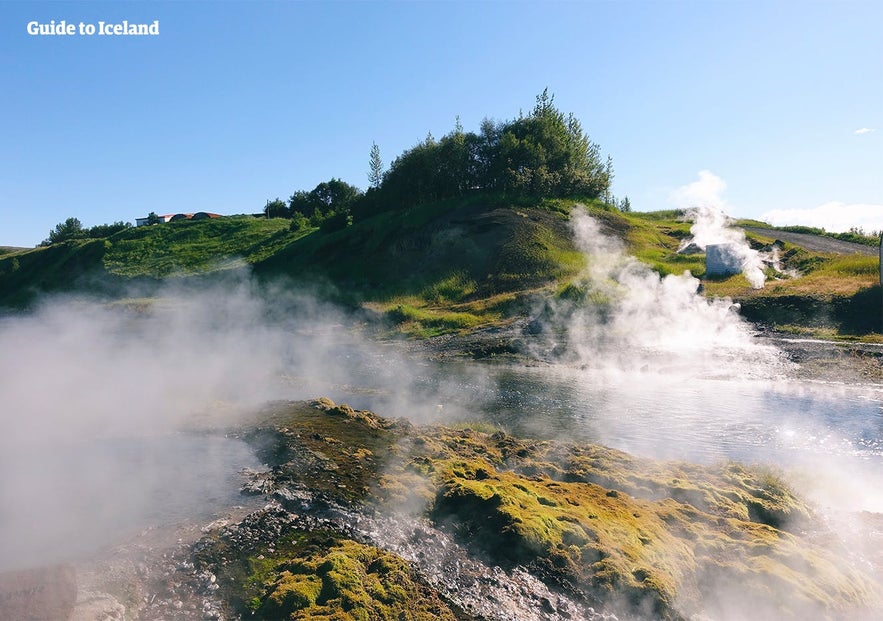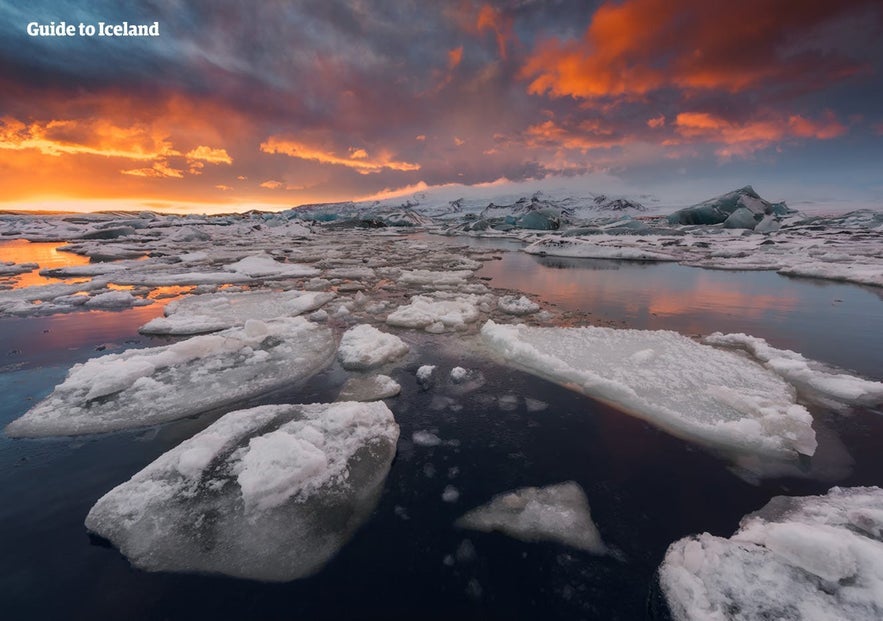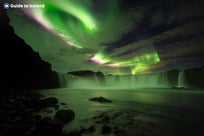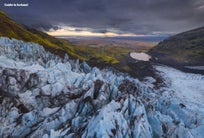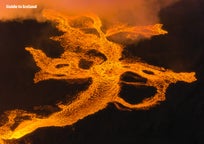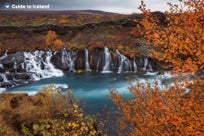
What to Do During a Stopover in Iceland

- Making the Most of Your Stopover in Iceland
- 4-6 hours Stopover Time
- Reykjanes Peninsula
- The Blue Lagoon Spa
- 6-8 hours Stopover Time
- Reykjavik
- Whale Watching From Reykjavik
- 8-10 hours Stopover Time
- Golden Circle Sightseeing Route
- 10-12 hours Stopover Time
- Kerid Crater
- Secret Lagoon
- Day Tours: Volcanoes, Lagoons & Helicopters
- 12-24 hours Stopover Time
- The South Coast of Iceland
What are the best options for your stopover in Iceland? What sites are within close proximity to the airport? Will you need a rental car, and how will time restraints shape your stay? Find all you need to know about what to do during your stopover in Iceland.
Iceland has long been a popular place for stopovers among passengers traveling between North America and Europe, providing a great opportunity for an "extra vacation" where you can get a little taste of the country's magic. Iceland’s major airlines offer stopover plans when booking a flight to encourage visitors to maximize their time here at little to no additional cost!
With just a few hours in Iceland, you can experience the renowned Blue Lagoon geothermal spa or see the dramatic nature of the Reykjanes peninsula. With a full day, discover the Golden Circle or go on South Coast tours before relaxing in cozy Reykjavik accommodation. There are also plenty of hotels in Keflavik if you have an early flight!
Plan an amazing stopover with this helpful guide. Learn how to optimize your visit to Iceland and find the best things to do, no matter how long you're staying!
- Learn more: All Airlines That Fly to Iceland: Best International and Domestic Flight Options
- See also: How Many Days to Spend in Iceland
Making the Most of Your Stopover in Iceland
It's easy to find transfers bewteen Keflavik Airport and Reykjavik with a stop in the Blue Lagoon.
When you have a stopover in Iceland, it’s important to plan wisely to maximize your time and to experience the best this unique country has to offer. Start by deciding how long you have and what interests you most, whether it's exploring natural wonders, soaking in geothermal spas, or exploring the streets of Reykjavik.
Decide if you prefer booking tours or getting a rental car at Keflavik Airport for flexibility and ease of travel. It can be a great option for longer stopovers, especially if you plan to venture beyond Reykjavik.
Below, you will find detailed itinerary ideas for different stopover lengths, giving you clarity on what is actually achievable during your visit. These are sure to give you an exciting taste of Iceland and leave you craving a return trip!
- See also: What To Do With Three Days in Iceland
4-6 hours Stopover Time
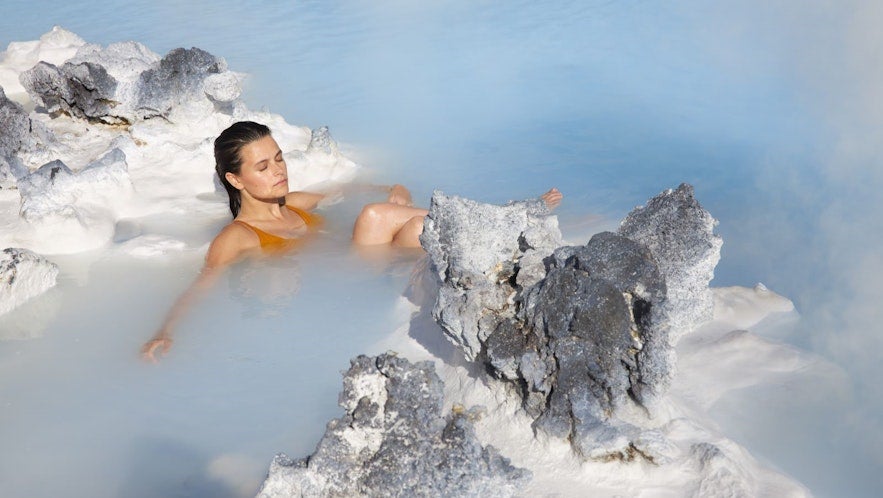 So let’s face it, you’re short on time from the outset, but who wants to spend their layover sitting around in some airport lounge? With four to six hours, there are only two options that grant you enough time to experience a little of the country and get back in time for check-in; visiting the Blue Lagoon or sightseeing on the Reykjanes Peninsula.
So let’s face it, you’re short on time from the outset, but who wants to spend their layover sitting around in some airport lounge? With four to six hours, there are only two options that grant you enough time to experience a little of the country and get back in time for check-in; visiting the Blue Lagoon or sightseeing on the Reykjanes Peninsula.
- See also: What To Do with 4 days in Iceland
Reykjanes Peninsula
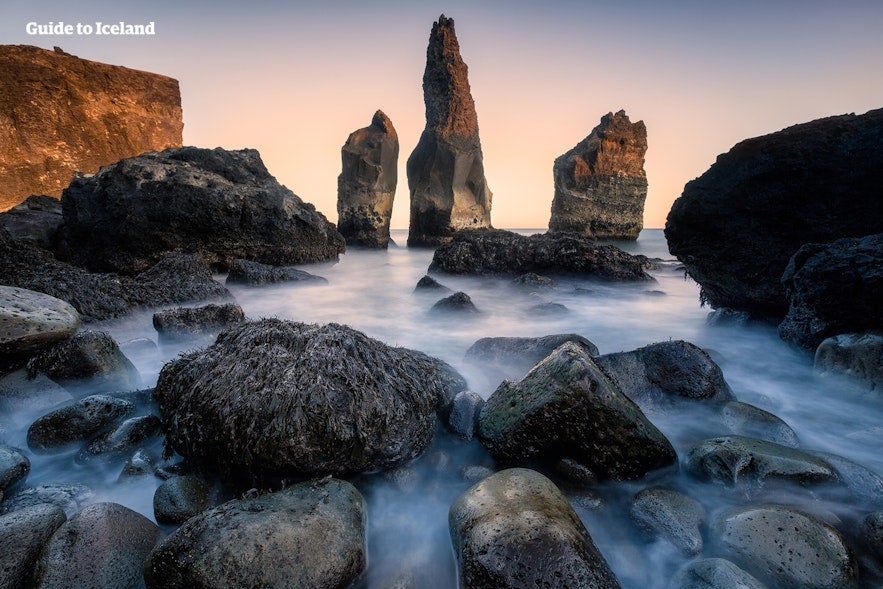 Luckily, both the Blue Lagoon and Keflavik International Airport are located on the Reykjanes Peninsula, meaning your commute time is almost zero. If you have to stay overnight, you can even find accommodation near Keflavik Airport for optimal convenience.
Luckily, both the Blue Lagoon and Keflavik International Airport are located on the Reykjanes Peninsula, meaning your commute time is almost zero. If you have to stay overnight, you can even find accommodation near Keflavik Airport for optimal convenience.
The region is a UNESCO Global Geopark, characterized by its stark and haunting coastlines, dark volcanic fields, and the distant Blue Mountains, Blafjoll, forever watching from the horizon. The area is also the only place in the world where it is possible to see the Mid-Atlantic Ridge above sea level, at a location known as the "Bridge Between Continents."
For an insight into Iceland’s early history and culture, you can pay a visit to Viking World, a museum on the outskirts of Keflavik. It has an enormous replica of a 9th-century Viking ship, and it's an interesting place to absorb yourself in this country’s history.
- See also: The History of Iceland and the History of Reykjavik
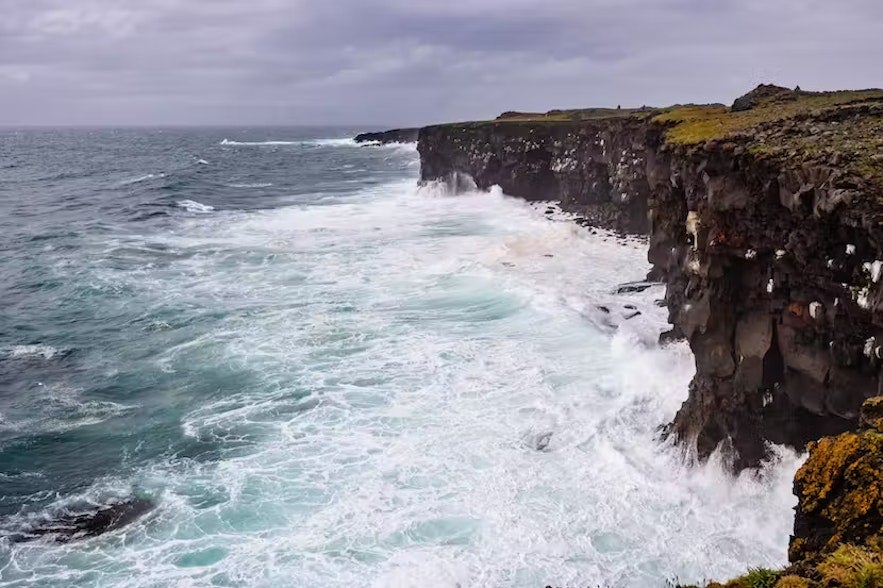 Most visitors to Iceland come for nature, which is lucky given Reykjanes’ abundance of incredible natural attractions. Those looking for interesting rock formations need to look no further than the Hafnarberg cliffs, known as much for their dynamic, weatherbeaten shape and their eclectic birdlife.
Most visitors to Iceland come for nature, which is lucky given Reykjanes’ abundance of incredible natural attractions. Those looking for interesting rock formations need to look no further than the Hafnarberg cliffs, known as much for their dynamic, weatherbeaten shape and their eclectic birdlife.
If, instead, you’d like to see the area’s geothermal underbelly, there can be no better recommendation than visiting Gunnuhver, an area of impressive, steaming fumaroles and bubbling mud pools. Gunnuhver is, without doubt, the premier location for gaining a deeper insight into the elemental forces that have sculpted Iceland throughout the preceding centuries.
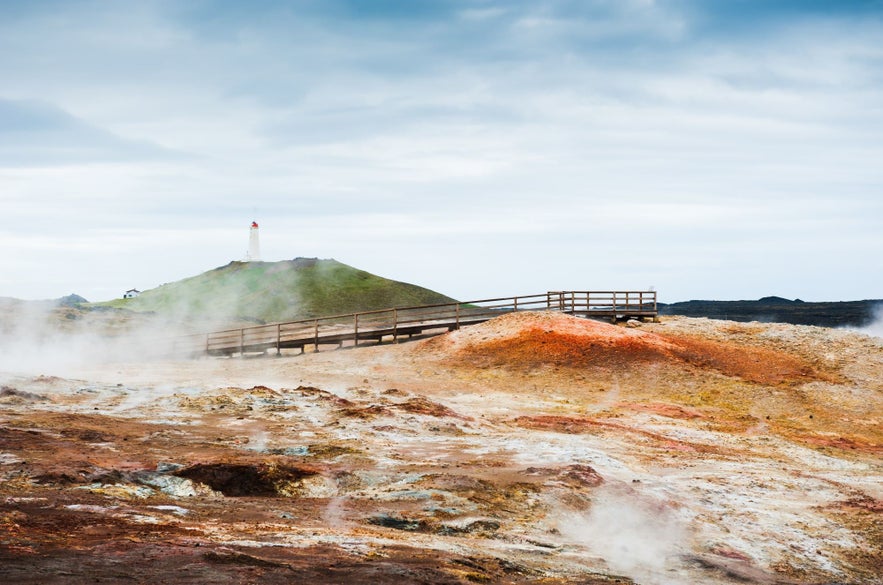
Other areas that may be of interest include the lake Kleifarvatn and the beautiful cone-shaped mountain, Keilir. If, in this brief time in Iceland, you want to breathe in that fresh ocean air, Reykjanesviti lighthouse is the place; beloved by photographers and nature lovers alike, the beach beside the lighthouse is, perhaps, the most stunning stretch of shoreline on the whole Reykjanes peninsula.
The Blue Lagoon Spa
The vastly popular choice for a stopover is to spend some time soaking in the world-famous Blue Lagoon spa. The Blue Lagoon draws visitors from across the world with its vivid azure waters, healing silica mud, and gnarled, rocky surroundings.
- See more: The Ultimate Guide to the Blue Lagoon
- Also, check out the Blue Lagoon vs. Sky Lagoon: Which One Should You Visit?
This is one of Iceland’s most important attractions, yet it has limited space, with bookings needing to be made many weeks in advance. To reiterate, if you turn up on the day without having pre-booked your time slot, you will sadly be turned away. This is a common disappointment amongst holiday-makers, one that can be easily avoided with a little preemptive knowledge. You'll want to book your Blue Lagoon tickets well in advance to prevent disappointment!
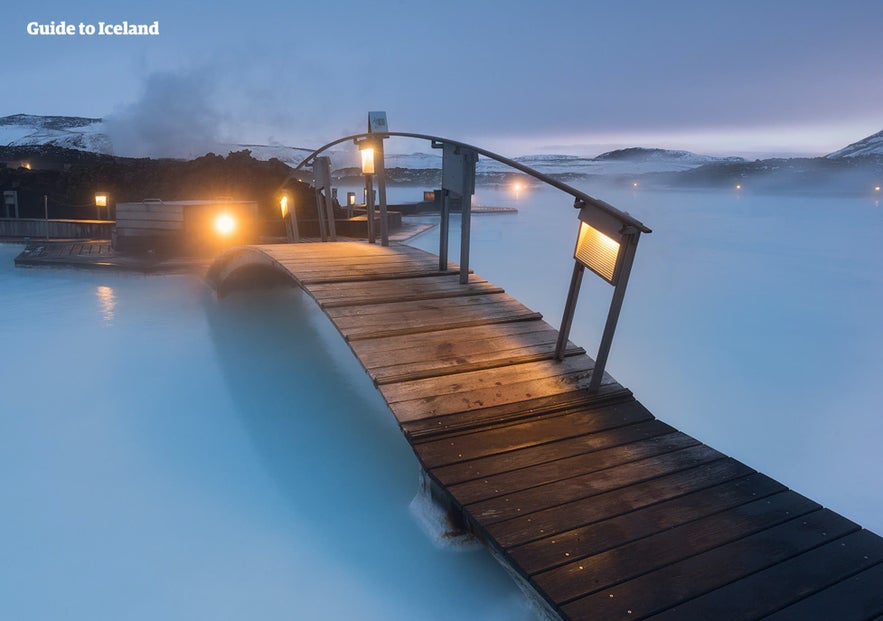
On that subject, the Blue Lagoon spa is known for the rejuvenating properties of its water, boasting minerals such as silica that are known to be beneficial for skin conditions like Psoriasis. The Blue Lagoon Spa also offers a variety of treatments and skin products that make for great souvenirs.
Stopover visitors with 4-6 hours to spare—and depending on the season, opening hours, and time of their arrival—may be in for one of two of Iceland’s greatest treats, both of which are best enjoyed bathing in the lagoon: the midnight sun (Summer) or the northern lights (Winter).
While the midnight sun can be guaranteed in June and July, seeing the northern lights is down to your luck. Nature, after all, is full of surprises. If you are one of the lucky ones who manage to catch these at the Blue Lagoon, you've really experienced one of the most magical aspects of Iceland's nature.
Sadly, however, given time restraints, you won't have time for more activities, meaning that it's goodbye to Iceland for now. But WHAT IF you had a little longer in the country? What might the options be, then?
6-8 hours Stopover Time
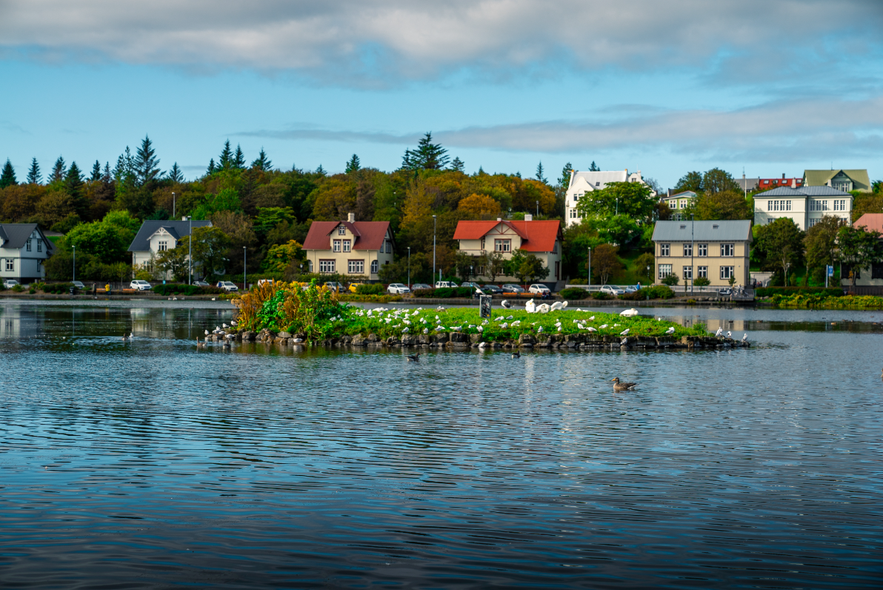 So, you’ve managed some extra time, extending your stopover in the country by two hours. Now is the perfect amount of time to get a short, bite-sized experience of Iceland’s capital city, Reykjavik. Its name translates to “Smoky Bay,” and it is Iceland's only formal city, with a population of approximately 135,000, with 240,000 living in the surrounding Capital Region.
So, you’ve managed some extra time, extending your stopover in the country by two hours. Now is the perfect amount of time to get a short, bite-sized experience of Iceland’s capital city, Reykjavik. Its name translates to “Smoky Bay,” and it is Iceland's only formal city, with a population of approximately 135,000, with 240,000 living in the surrounding Capital Region.
Reykjavik
Reykjavik is the northernmost capital in the world, founded by the island’s earliest settler, Ingólfur Arnarson, around 870 AD. As such, the city to this day maintains its Scandinavian heritage in its architecture, art and culture.
- See also: Music In Iceland and Wildlife and Animals in Iceland
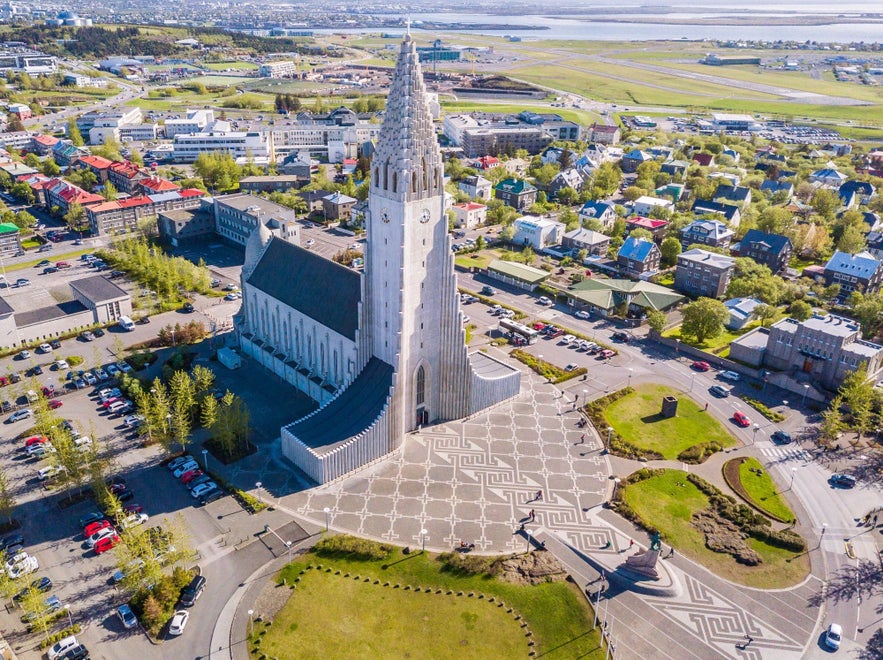
Requiring only a 45-minute drive from the airport to reach the city’s central downtown area, Reykjavik has all that one could ask of a modern metropolitan city: museums, art galleries, a botanical garden, lively shopping, fine cuisine, and a vibrant nightlife.
At the same time, Reykjavik feels in many ways more like a village than the capital it is, with a widespread basin of homes and businesses built against the Atlantic Ocean. Overlooking this quintessentially Icelandic settlement is the great mountain, Esjan.
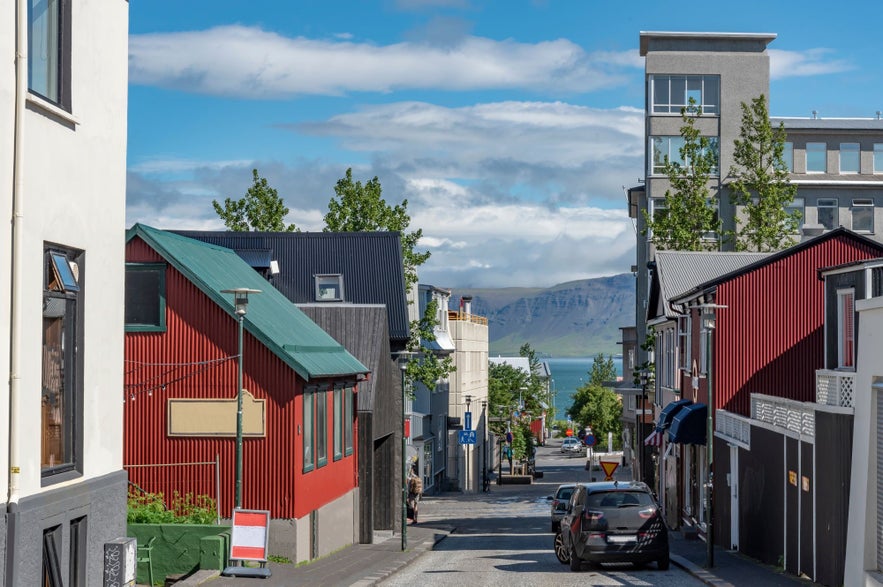
You can spot the Esjan mountain from Reykjavik's colorful streets.
6 to 8 hours in Iceland allows you to see many of Reykjavik’s major cultural landmarks. This includes the likes of Harpa Concert Hall and Conference Centre, instantly recognisable for its post-modern architecture and abundance of uniquely shaped glass windows. Another is Hallgrimskirkja, the iconic Lutheran Church whose architecture was directly inspired by the basaltic lava columns found across Iceland’s cliff faces and waterfalls.
Perhaps the most inspiring location, however, may be Perlan, a museum and observation deck. From this vantage point, you will have a full panoramic view of Iceland’s capital, as well as its nearby towns, distant mountains, and surrounding countryside and shorelines. It's the location of the Wonders of Iceland exhibition, which is one of the best things do to in Reykjavik!

Whilst in the city, it would be remiss to skip out on trying authentic local cuisine, despite what you may have heard about food in Iceland. Of course, Hákarl (aka; fermented shark) and a shot of Brennivín (aka; Black Death) are the go-to food for strange expressions and retching, but there are numerous other examples of Icelandic dishes that are destined to make the tastebuds water.
- See more: Food in Iceland | An Introduction to Icelandic Cuisine
- Make sure to check out the Best Restaurants in Reykjavik
Naturally, the Icelanders are experts at preparing delicious fish and seafood but are now experimenting with a range of cultural and culinary fusions, prepping their ingredients and flavors in new and exciting ways. The Icelandic lamb has also received a Protected Designation of Origin (PDO) for its tenderness and unique taste, making it a must-try.
You should also try the cultural staple here; the Icelandic hot dog! It's the perfect snack food for your time in the city.
Whale Watching From Reykjavik

Photo from The Reykjavik Whale Watching Tour
Another option on this day, if you feel you have the time, is to take a whale-watching tour from Reykjavik Old Harbour. Drifting out onto Faxafloi Bay on a modern and comfortable vessel, you’ll have a first-hand experience of some of Iceland’s most majestic natives: whales, dolphins, porpoises, and a wide variety of birdlife.
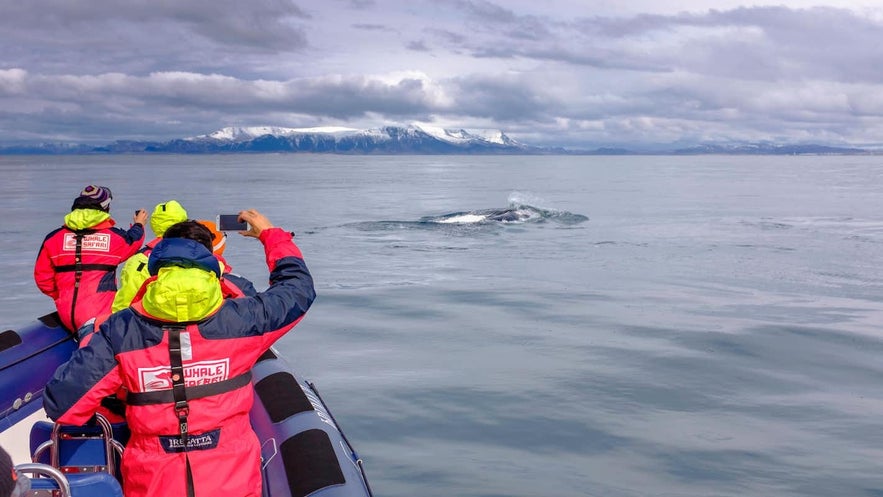
Photo from Up Close 2 Hour Whale & Puffin Watching Boat Tour from Reykjavik
Over twenty different species of cetaceans call Icelandic coastal waters their home, including the likes of orcas, blue whales, and harbor porpoises. The most common sightings on whale-watching tours are of minkewhales and humpbacks. Whale-watching tours will usually take 2-3 hours, leaving ample room to leave from Keflavik, partake in the experience, and return for check-in.
8-10 hours Stopover Time
Once again, time restraints are a concern, given the time already used up on logistics and waiting in the airport. Yet, with a little longer on the clock, there's the opportunity to explore further afield, away from Reykjavik, getting right out amidst the very best of Iceland's natural environment.
Golden Circle Sightseeing Route
With an 8-10 hour layover time, you will have the opportunity to do a tour of the Golden Circle, Iceland’s most popular sightseeing route. The Golden Circle is comprised of three main sites: Thingvellir National Park, the Geysir geothermal area, and the Gullfoss waterfall. Even if you don't manage to fit in all of them, each site is worth a visit on its own!
- See also: National Parks in Iceland
It's very convenient to do the Golden Circle route with an affordable rental car as you have more control over your time schedule. Many guided tours take up to eight hours or more, though tours with smaller tours can be shorter. For example, this afternoon Golden Circle tour is only six and a half hours, while this sightseeing bus tour is around 7 hours.
Just be mindful of your time, and make sure to leave some flexibility in your schedule. This will ensure that you won't risk missing your upcoming flight onward.
The first stop of the day is Thingvellir National Park, approximately one hour and twenty minutes away from Keflavik Airport. Thingvellir has been declared a UNESCO World Heritage Site and for a number of reasons.
First and foremost, this is one of the only locations on the planet where it is possible to see both the Eurasian and North American tectonic plates exposed from the Earth. These plates are separating little by little each year, creating a rift between them.
Thus, the Thingvellir National Park can be characterized by its moss-blanketed, volcanic rock formations, surrounding mountains, and numerous glacial springs, the most famous of which is Silfra Fissure.
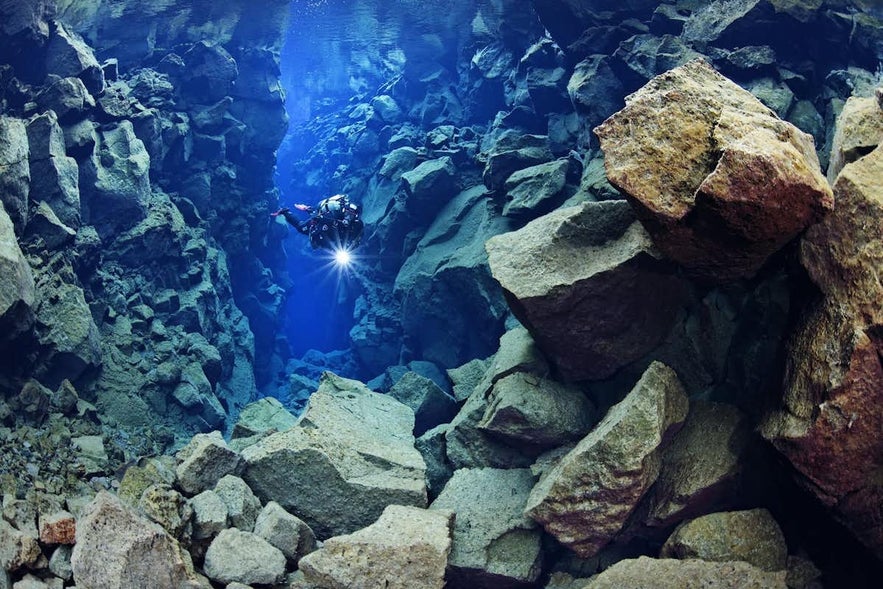
Photo from Incredible 3 Hour Guided Drysuit Diving Tour in Silfra with Hot Drinks
Silfra is known to be among the top 10 scuba diving and snorkeling spots in the world. Glacial water runs approximately 31 miles (50 kilometers) from the glacier, Langjokull, through underground tunnels, finally making its way into the open fissure.
Snorkeling or scuba diving in Silfra Fissure both manage to balance unmatched aesthetics with a sense of awe, fun, and exhilaration. No doubt, the water in Silfra Fissure is cold, but your guide will be sure to provide you with all of the necessary thermal protection.
- See also: Scuba Diving and Snorkelling in Iceland
The second major reason for its UNESCO status is its relevance to Icelandic history and culture. Thingvellir was the original founding spot of the Alþingi parliament, having been established there in 930 AD. This makes it one of the oldest elected parliaments in the world.
Haukadalur valley is best known for the hot springs Geysir and Strokkur. Whilst Geysir is no longer active, it is remembered for having given its name to geysers all across the world.
Strokkur, on the other hand, will reliably erupt every five to ten minutes, often shooting jets of water as high as 82 feet (25 meters) into the air. This is perfect for photographers and nature lovers alike who crowd around this hot spring, waiting for that Kodak moment!
The final stop of your day is at the mighty waterfall, Gullfoss, found along the Hvita river. The name is Gullfoss, which translates to the “Gold Waterfalls,” and has long been a favorite among Icelanders. Visitors to the falls will see 104 feet (32 meters) of cascading white froth dropping dramatically into the glistening canyon, Gullfossgljufur, below.
10-12 hours Stopover Time
With half a day to spare, you have far more options for activities. These are some of the unique places and experiences you can enjoy with this longer time frame for your visit.
Kerid Crater
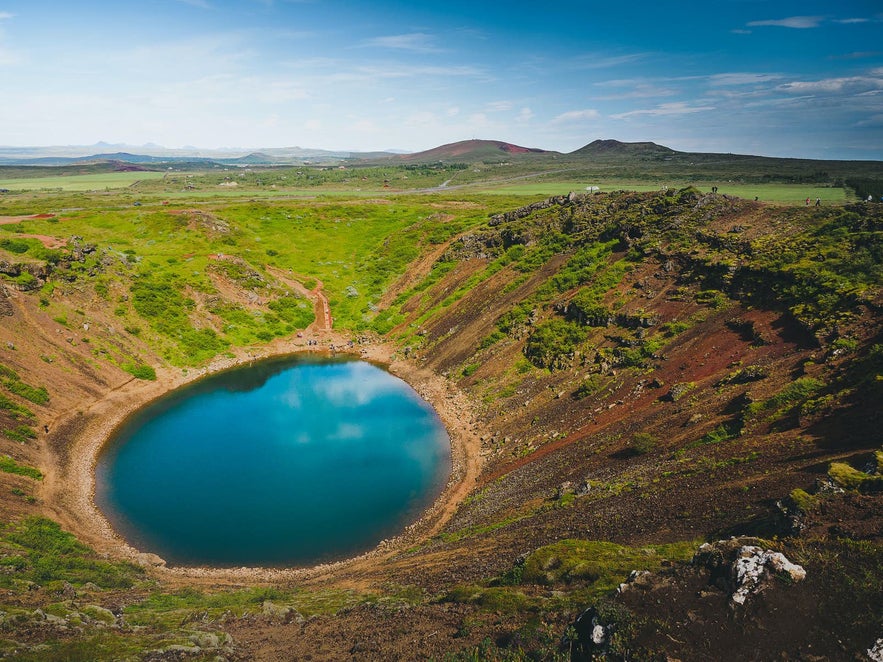 Photo from Minibus Tour | Golden Circle & Kerid Volcanic Crater
Photo from Minibus Tour | Golden Circle & Kerid Volcanic Crater
With a 10-12 hour stopover time in Iceland, it is possible to see all three major attractions of the Golden Circle sightseeing route, plus some added extras. For instance, one of the most beautiful crater lakes in the country, Kerid, is found approximately twenty-five minutes drive from Thingvellir National Park.
Located within Iceland’s Grimsnes region, Kerid is instantly recognizable thanks to a number of features; the crater has steep sides, blanketed with vegetation, with a vibrant aquamarine lake at its bottom.
Kerid is just one of the many craters found in Iceland’s West Volcanic Zone, though it is, without doubt, the most beautiful. Visitors to the crater are invited to walk around its outer rim or descend the gentlest embankment down to the lake. There is a 600 ISK entrance fee, with parking on site.
- Learn about Iceland's Volcanoes: The Complete Guide
- See also: Volcanic Eruptions in Iceland: A History of Fire
Secret Lagoon
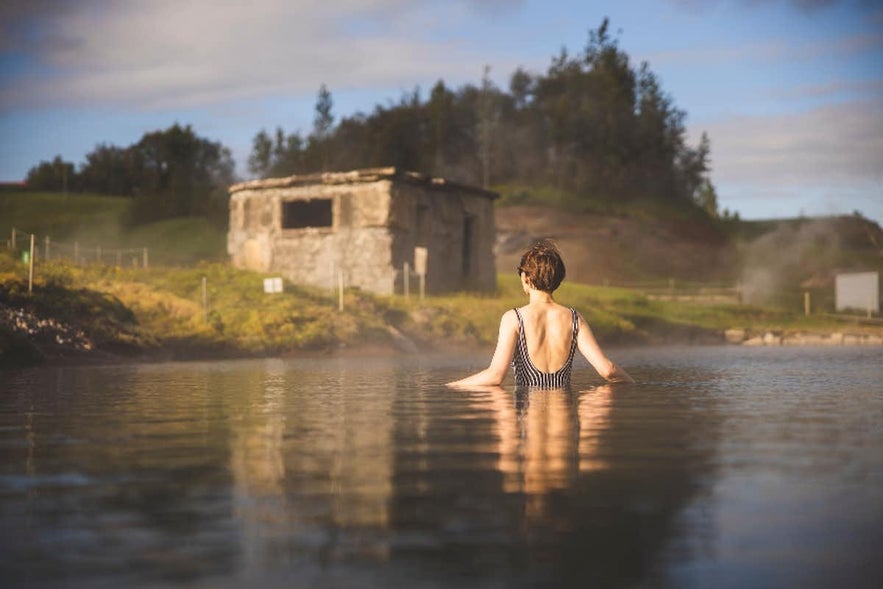 Photo from Classic 8 Hour Small Group Tour of the Golden Circle & Secret Lagoon with Transfer from Reykjavik
Photo from Classic 8 Hour Small Group Tour of the Golden Circle & Secret Lagoon with Transfer from Reykjavik
Whilst in the general area, another option could be making a stop at the Secret Lagoon, Iceland’s oldest outdoor swimming pool. Like most geothermal hot springs in Iceland, the Secret Lagoon appreciates pre-booking, allowing you to secure the time you would like at the lagoon.
It is advised to bring your own towel and swimwear, though these can also be rented from the establishment itself. Snacks and drinks are also available for those feeling a touch peckish after bathing.
Visitors to the Secret Lagoon will have the chance to bathe surrounded by all kinds of natural geothermal features, from gurgling hot springs to steaming cauldrons of mud. The Secret Lagoon is as authentic as outdoor bathing can come in Iceland.
Day Tours: Volcanoes, Lagoons & Helicopters
Depending on the time of your arrival and departure from Iceland, you may fit within the timeframe to partake in day trips from Reykjavik with a guided operator.
Day tours in Iceland allow you to see and experience the very best tours and activities with an experienced and knowledgeable adventure guide. They can provide a level of insight otherwise unobtainable to the lone traveler.
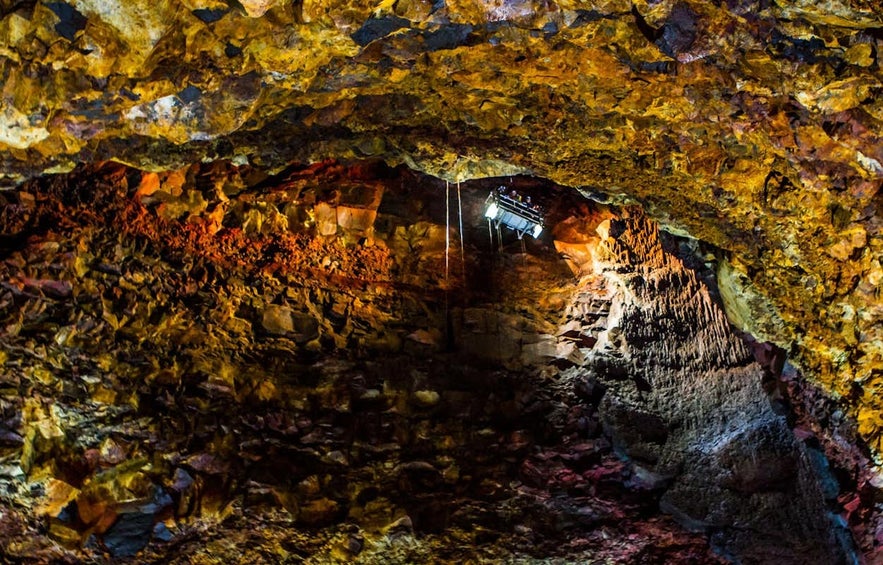 Photo from Inside the Volcano Thrihnukagigur Tour with Transfer from Reykjavik
Photo from Inside the Volcano Thrihnukagigur Tour with Transfer from Reykjavik
One of the most popular day tours available is exploring the inner depths of a volcanic magma chamber (...don’t worry, we’re talking a dormant volcano here!) Hiking 2 miles (3.2 kilometers) to Thrihnukagigur volcano, you will enter into an elevator, then descend 649 feet (198 meters) into a rocky abyss of fascinating magma formations and lava-emblazoned inner walls. Your descent will last an incredible six minutes in total!
- See also: Top 7 Volcanic Experiences in Iceland
Once you are at the bottom of the volcano, you’ll have half an hour to roam, during which time you will want to keep your camera handy; the immense size of the volcano’s caldera, the explosion of colors, the distant opening, so high and far away, are all sure to awe-inspire a wealth of fantastic photographs.
Your guide will also make sure to teach you all about Iceland’s geothermal underbelly, as well as the devastating impact that volcanoes have made on Iceland’s history.
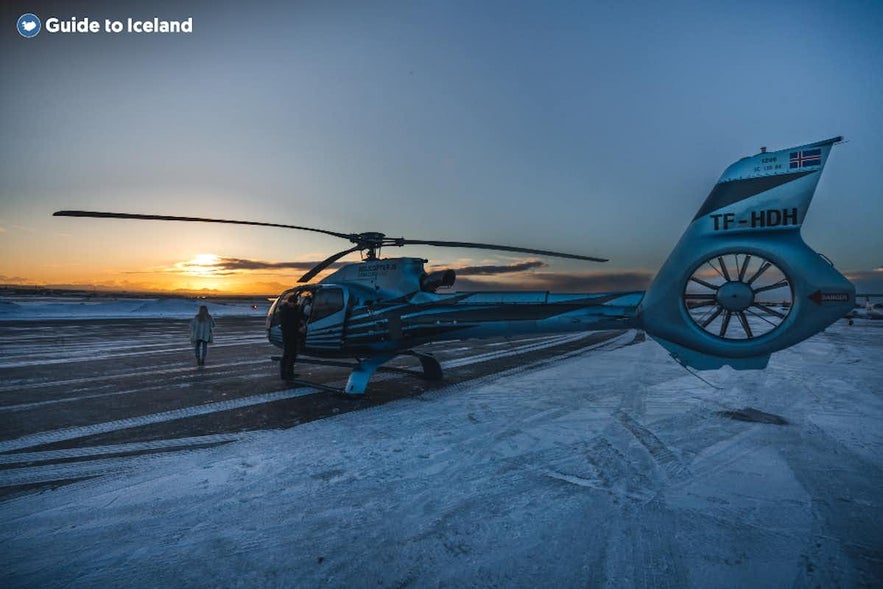 From Amazing 40 Minute Helicopter Tour of Reykjavik with a Mountain Summit Landing
From Amazing 40 Minute Helicopter Tour of Reykjavik with a Mountain Summit Landing
Another popular option for a day tour, though a little on the pricier side of the market, is taking a helicopter tour. There really can be no better way of experiencing as much Icelandic beauty in such a short time frame than soaring over the country’s volcanic fields, its snow-peaked mountain ranges, its eclectic coastlines, and lush grazing meadows.
All the while, you’ll be overcome with a wild sense of exhilaration thanks to the speed, drama, and action that comes hand in hand with helicopter flight-seeing.
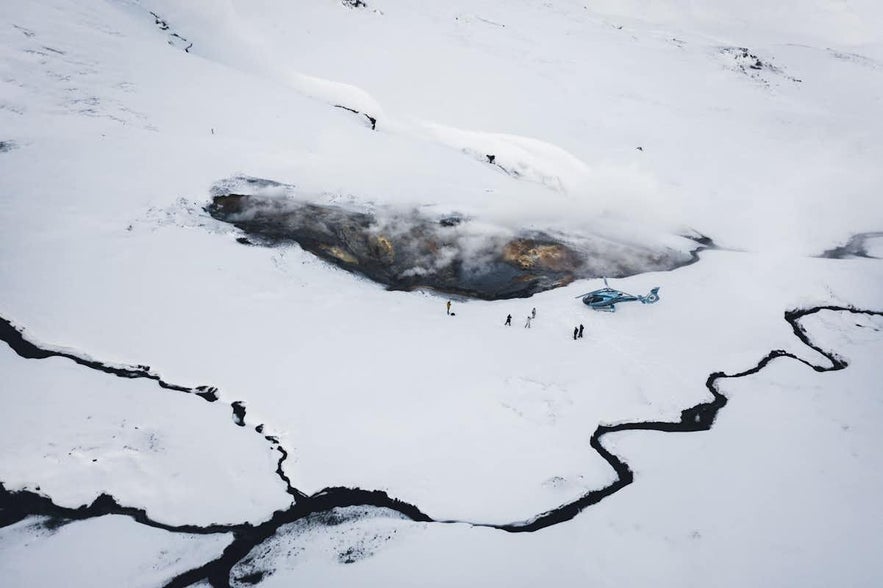
Photo From: Fascinating 1 Hour Helicopter Tour of Geothermal Sights with Transfer from Reykjavik
Helicopter tours not only allow you to see some of the country’s most beautiful sites within the shortest time, but they also present the opportunity to land and explore otherwise inaccessible regions. One of the best examples of this is the Reykjavik Summit Tour, taking you from base camp at the city’s domestic airport to one of the highest caps of the Blue Mountains, providing staggering panoramic views of the island’s capital region.
One of the great benefits of a helicopter tour is how time-effective it is. This allows you to spend the remainder of your stopover sightseeing or partaking in the second half of a combo tour. One popular choice is to combine the likes of a helicopter tour with an ATV or Buggy tour, allowing you to explore and discover Iceland by both land and air.
12-24 hours Stopover Time
If you have a full day in Iceland, that will leave approximately 10 hours of free time to explore and discover. If you consider the day minus 8 hours of sleep, a 90-minute round trip from Keflavik Airport to Reykjavik, and a two-hour check-in and boarding process, there is still a lot that can be achieved with the leftover timeframe, especially if you're careful to maximize your time in the country.
The South Coast of Iceland
One of the options only available to those with the time to spare is exploring elements of Iceland’s gorgeous South Coast. Reaching the first attraction of real interest, Seljalandsfoss will take approximately one and a half hours from Reykjavik, whilst the South Coast’s final attraction, the Jokulsarlon glacial lagoon, will take approximately four and a half hours, without stops.
With a full 24-hour stopover, there will be enough time to reach this final attraction on the South and make it back to the hotel for a quick cat nap or directly to the airport.
Seljalandsfoss and Skogafoss are two of the best-known waterfalls on the South Coast. Both stand at around 197 feet high (60 meters), though the former is a far narrower cascade and also boasts an accessible cave behind the falls, thus ensuring your chance to get some truly unique landscape photographs.
Skogafoss, on the other hand, is much wider, 82 feet (25 meters), thus creating an enormous plume of mist at its base that, on sunny days, is sure to form rainbows, complimenting your photography further. It is possible to view Skogafoss from the bottom or ascend the staircase adjoined to the mountain from which it falls, allowing you the chance to view the feature from above.
Reynisfjara Black Sand Beach is one of the most beautiful non-tropical beaches in the world, as voted for by National Geographic magazine. The area is renowned for its jet-black pebbles, incredible basalt lava columns, and the iconic Reynisdrangar rock stacks, one of the great sights of the Icelandic South Coast.
Those with the time to spare might also make a quick stop at the small peninsula of Dyrholaey, which, from its high vantage point, grants a fantastic view over this picturesque region.
Jokulsarlon glacial lagoon is often regarded as "the Crown Jewel of Iceland" thanks to its sheer aesthetic appeal and popularity despite its distance from the Capital Region. Those who make the stop will be privy to enormous icebergs breaking away from the glacial outlet tongue, Breidamerkurjokull, a part of the much larger Vatnajokull glacier, before drifting idly on the lagoon's flat, azure surface.
Jokulsarlon glacial lagoon is as far as one can get safely on a 24-hour stopover; if one is planning to visit the lagoon, make sure to keep a constant eye on both the weather—climatic surprises may cause countless delays—and on your timekeeping at each attraction. Traveling around Iceland is both mesmerizing and addictive, and it is surprisingly easy to get distracted and let time slip away.
Make sure to travel within your limits whilst on a stopover in Iceland, and ensure that you have some pre-knowledge on airport transfers, what you will be doing, and whether you will need to book any activities in advance of your arrival.
What would you want to do during a stopover in Iceland? Have you visited before? Did you feel like you had enough time to see what you wanted? Make sure to leave your thoughts and comments in the comment section below.
Andre spændende artikler

Kørsel i Island: Den ultimative guide til roadtrips
Lær alt, hvad du ønsker at vide, om kørsel i Island. Find ud af, hvorfor det er nemt at køre i Island om sommeren og mere vanskeligt om vinteren. Lær, hvordan du lejer en bil til din kør-selv-ferie,...Læs mere
Islands vejr, klima og temperaturer året rundt
Få alt at vide om vejret på Island. Da det er en ø med ekstremer, er vejret ingen undtagelse. Find månedens gennemsnitstemperatur, vejret på de enkelte årstider, hvordan vejret skifter mellem de forsk...Læs mereIsland med børn | En familieguide til Island
Hvordan er det at rejse til Island med børn? Hvilke ture, aktiviteter og spændende oplevelser har dine børn lov til at deltage i? Hvad er de mest spændende aktiviteter for din islandske familieferie...Læs mere

Download Islands største rejsemarkedsplads til din telefon for at administrere hele din rejse på ét sted
Scan denne QR-kode med dit telefonkamera, og tryk på det link, der vises, for at lægge Islands største rejsemarkedsplads i lommen. Indtast dit telefonnummer eller din e-mailadresse for at modtage en sms eller en e-mail med downloadlinket.
